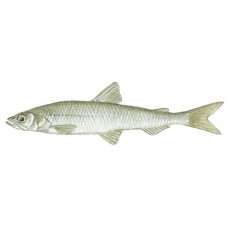Latin name
Osmerus eperlanus
Other names
European Smelt
Identification
Like salmon and trout, the smelt has a spiny adipose fin just in front of the tail. The lower jaw protrudes slightly beyond the tip of the snout. The lateral line is prominent and there are no scales on the head. The Smelt is usually a small (most grow no more than 8 inches) schooling fish, often found in huge numbers. The European Smelt has an elongated body covered with large, easily fallen scales. The mouth is large, and the teeth are weak (especially on the upper jaw). The lower jaw is prominent forward. The lateral line is not perfect, ending on the 4th-16th scales. Dorsum olive green, flanked by a longitudinal silvery stripe, lower body creamy white.
Distribution
All smelt inhabit the cool waters of the Northern Hemisphere in the Atlantic, Arctic and Pacific Oceans and their drainages. The family belongs to the salmonids, contains 11 species in six genera, and is most widely represented in the waters of the Pacific Ocean. It is found in lakes of Sweden and Germany, in Western Europe it is distributed to Ireland, Great Britain, and reservoirs of northwestern France.
Habitat
Some smelt are marine in origin, but have adapted to a purely freshwater environment. Populations of some species live both in the sea and in fresh water. Passable lake-river and lake fish. Prefers deep lakes with a good oxygen regime.
Size
European Smelt is up to 30 cm long and lives up to 9 years. Rapid growth rate in the first year of life is characteristic. Usual length of 6-10 cm, rarely up to 15-18.5 cm. Reaches sexual maturity at 3-4 years of age.
Life history and Behavior
In spring, huge numbers of Smelt move from their marine or freshwater habitats to tributary waters to spawn. Only one species, the anadromous Pacific longfin smelt (Spirinchus thaleichthys), spawns in late fall and early winter. All species spawn at night. In North America, pond smelt (Hypomesus olidus) and rainbow smelt (Osmerus mordax) are considered excellent food fish. In terms of quantity, freshly caught smelt have a smell more reminiscent of cucumber than fish.
Food and feeding habits
The basis of food - zooplankton, also eats personal eggs and juveniles, young of other fish (herring, bass).
Reproduction
The European Smelt spawns in spring, from mid-April to the end of May at water depths from 1 to 3.5 m at water temperatures from 0.5 to 7.0 °C near the coasts on stony coarse-sand and pebble soils, as well as on vegetation. It enters the lower reaches of rivers to spawn. A distinction is made between lake smelt (entering rivers) and lake smelt (spawning in the lake). The eggs are small and sticky. The unfertilized eggs are 0.7-1 mm in diameter. Larvae hatch at a water temperature of 10 °C after one month and after 16-20 days at a water temperature of 14-15 °C.
| Classification | |
| Phylum | Chordata |
| Class | Actinopterygii |
| Squad | Osmeriformes |
| Family | Osmeridae |
| Genus | Osmerus |
| Features | |
| Conservation status | Least Concern |
| Habitat | Littoral |
| Life span, years | 6 |
| Maximum body weight, kg | No information |
| Maximum length, cm | 30 |
| Sailing speed, m/s | No information |
| Threat to people | Edible |
| Way of eating | Predator |
Smelt
Tags: Smelt



